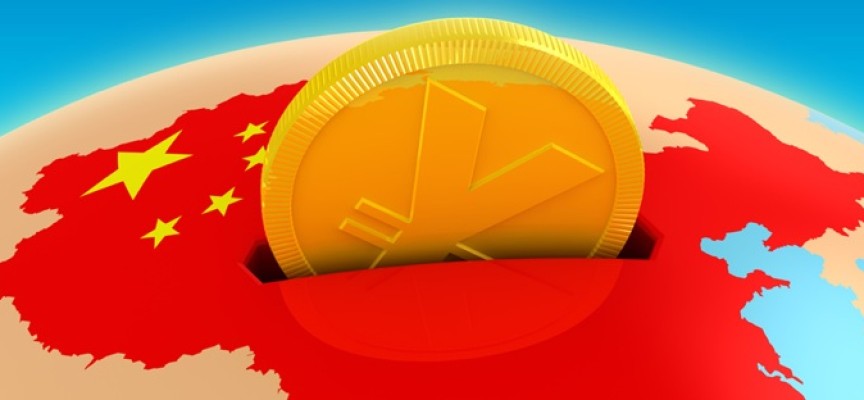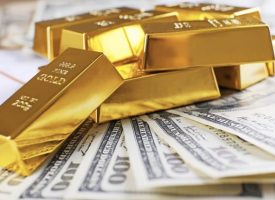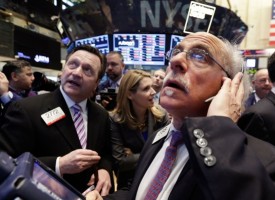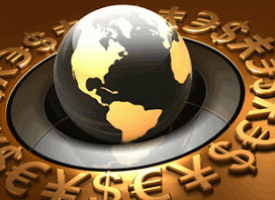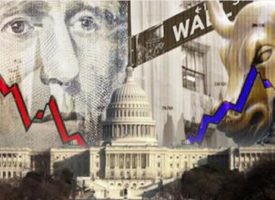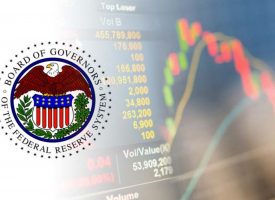Today a legend in the business sent King World News a powerful piece that warns the West is now in serious trouble as confidence in Western central banks and their currencies is rapidly fading. John Ing, who has been in the business for 43 years, also discussed China’s master plan to crush the West and dominate the world, which will include instituting a new gold-backed system.
By John Ing of Maison Placements
November 13 (King World News) – Everything is rosy, or is it? The Dow is flirting with 18,000 again but stocks are overvalued. Positive economic news is not so positive because it means that the Fed will push up rates. Bad news is just bad news…
Continue reading the John Ing piece below…
Advertisement
To hear which company investors & institutions around the globe are flocking to
that has one of the best gold & silver purchase & storage platforms
in the world click on the logo:

100 Million Jobless
Domestically, Barrack Obama has been a disaster. For example, take ObamaCare, which is inefficient, expensive and unpopular as ever. Or that a record number of Americans have dropped out of the labour force with almost 100 million jobless. And of course despite printing trillions, economic growth remains tepid. The Nobel Peace Prize winner’s Middle East agenda is in tatters. His credibility was again tested in another wrestling match with Congress over America’s debt limits. And unsurprisingly, then, he leaves an economy worse than he inherited and even in worse shape than it looks.
Since 2009, the Fed has purchased almost $4 trillion of Treasuries and mortgage backed debt, funding over half of the government’s federal debt load. Post crisis debt monetization and quantitative easing has poured trillions into the global financial system, creating credit bubbles. Yet despite rounds and rounds of quantitative easing, the world economies remain in a funk, laying the ground for another pump priming exercise. In fact, a “dithering” Fed has even lost credibility with the biggest beneficiary of its stimulus policy – Wall Street who feasted on the cheap credit. The world is simply addicted to this money creation exercise and cannot get off the treadmill.
Credibility on the Line
Despite the United States only accounting for 23 percent of global GDP, 60 percent of global foreign exchange reserves are in dollars. Seven years after the Lehman collapse, the US has added nearly $8 trillion of debt, doubling its debt-to-GDP ratio. But now that gap has created problems among the cartel of central banks because most currencies are linked to the dollar.
Central bankers were once bankers to the banks, however those stewards of money have become creators of money. Those imbalances also triggered a return to a currency war, reminiscent of the Thirties with a race to the bottom as each country sought a competitive advantage. The world’s financial system has become more unstable. China was the last to join the currency war and will soon pass the United States to become the world’s largest economy. That emergence, we believe will reshape America’s financial hegemony.
Much of America’s obligations are owed to foreigners which represents a clear and present danger for the dollar. America’s trading partners’ patience is wearing thin with America’s hegemonic power and use of its financial clout as a political tool. The dollar payment system has allowed America to impose financial sanctions on its adversaries, bully developing countries, close tax havens and dominate the financial world with its big Wall Street institutions. Today, most trade and transactions are conducted with dollar payments either directly or indirectly. As such global banks are largely American. Indeed this “exorbitant” privilege of owning the world’s reserve allows America to borrow in dollars, pay for spending, and finance a growing debt and huge deficits in a currency that it prints.
No Respect As U.S. Dollar Enters Paranoid Moment
The biggest worry is that America has become the center of global disorder. The United States, the world’s largest borrower, has become increasingly dependent upon its creditors. America’s debt holders have noticed and some countries like China are dumping dollars as China discovered that quantitative easing reduced returns on its massive dollar denominated reserves to near zero. China has already unloaded $100 billion in a move to support the renminbi. Saudi Arabia too has unloaded dollars as it dipped into depleting reserves to prop up spending and hedge the impact of falling oil prices. Russia unloaded dollars to offset the impact of sanctions and finance gold purchases. Brazil, Norway and Taiwan sold dollars having tapped out their rainy day reserves. In time, these sales will push up rates, with or without the Fed’s acquiescence.
Never mind that the dollars created are worth less and less, yielding diminishing returns such that the markets have become complacent because debt service costs are low. Traders are hoping for just one more bubble and another fool willing to pay even more. Despite Europe’s near death experience with fiscal recklessness, debt has exploded and is well above gross domestic product (GDP). Debt doesn’t seem to matter. It does. Debt must be paid off. Failure to pay not only leaves future generations the responsibility, but failure or even a hint of default damages the credibility of all debt.
The failure of the Fed to wrestle these problems has eroded trust in America’s ability to act as a financial steward of the world’s reserve currency. The dithering and politicking over a much overdue rate hike has increased volatility, undermining respect in the dollar. Still to come is the unwinding of America’s extraordinary monetary policy and the eventual symbolic first interest rate increase in a decade. The dollar has entered a paranoid moment, involving respect. Every move is about the loss of respect. Take China’s move towards globalizing the renminbi. Or take Europe’s latest moves. Or the perennial debt ceiling discussions which brought the US to the brink of debt renunciation only just avoided in 2011 and 2013. The whole concept of respect was waged before with Britain in the Thirties experiencing the decline of sterling. The dollar is the world’s currency. However, because the US consumes much more than it produces and owes much more than it owns, the creditors of America’s debt have a vote. This time there is no lender of last resort.
China’s Calling – Building New Gold-Backed System
China introduced a platform of financial reforms to liberalize the renminbi as a global currency and part of the foundation for a Sino-centric financial system. China also unveiled a package overhauling its gigantic debt ridden state-owned sector and targeted bureaucratic paralysis and corruption.
To revive its economy, the PBOC cut interest rates for the sixth time in a year. China recently shocked the world by devaluing and loosened the peg from the dollar, joining Switzerland, making the value of the renminbi more market oriented. In turn, the IMF will include the renminbi as a component of the Fund’s Special Drawing Rights basket (SDRs) of reserve currencies after the Americans dropped their resistance. China launched a cross border renminbi payment system with some nineteen banks encouraging the use of renminbi as a unit of settlement for trade in the West. China’s deep pockets have also created international lending institutions as part of the global architecture. Beijing sponsored the Asia Infrastructure Investment Bank (AIIB) which has the backing of more than 50 countries. Already China has set up North America’s first currency swap hub in Toronto, solving infrastructure problems and facilitating cross border transactions. As a result, the renminbi has become the fourth most used currency for global payments.
Among its many moves to globalize the renminbi and displace the dollar monopoly, China has been accumulating massive stocks of gold, accounting for one fifth of global investment demand. Today the US has about 8,000 tonnes of gold. China has purchased major supplies for the fifth month in a row and holds 1,722 tonnes, an increase of 668 tonnes from the 1,054 tonnes reported last in 2009. China’s purchases of gold, makes it the fifth largest holder of gold, moving ahead of Russia and Switzerland. We believe Beijing is increasingly viewing America’s profligacy through a lens of distrust, reminiscent when the baton of financial superpower was passed before. For now, the world’s largest bullion hoarders are building a new system, gold-backed and beyond the reach of American hegemony.
At the same time on the geopolitical front, Russia’s escalation of the Syrian conflict blindsided the West, crossing multiple red lines filling a vacuum left by America’s stealth departure from the Middle East. In the process, it appears that the partition of Syria is inevitable, tearing to shreds Mr. Obama’s Middle East plans leaving its allies on the beach. By calling the West’s bluff, Putin has slowly extended his reach from the Ukraine to the Middle East in a Catherine the Great type move. For allies, America’s world power is now in line with its ebbing financial power.
Monetary Reform
Needed is tough monetary reform. The Federal Reserve was created in 1913. Money was then linked to gold. Central bank reserves held only gold but in 1922, at a conference in Genoa, they decided to also hold currencies like pound sterlings and dollar IOUs. The gold standard morphed into a gold exchange standard with currencies elevated to money and dollar-based claims became equivalent to gold as part of central bank reserves. Subsequently and not surprisingly, the world soon was awash with printed liabilities with the postwar Bretton Woods system of fixed exchange rates existing from 1946 to 1971.
The system became flooded with more liabilities. In 1971, Richard Nixon was forced to end the dollar’s convertibility into gold to stop a run on America’s gold reserves as creditors demanded gold instead of dollars forcing the Americans to ultimately print yet more dollars. There followed a system of floating rates and soon dollars officially replaced gold. Of course, the world dollar’s base increased by quantum percentages. For seventy years, the dollar was the keystone of the world’s financial monetary system, allowing America to live beyond its means, financed largely by debt magnetization, a vastly expanded shadow banking sector and too big to fail financial institutions. Since the financial crisis, the tide of recovery has not lifted all boats equally.
Today what ballasts the US monetary system is debt. The potent challenge is that the world’s central banks have built up enormous hoards of each other’s debt with newly printed money as part of unorthodox quantitative easing. After two decades of financial globalization, global foreign currency reserves are now pegged at a whopping $12 trillion or a fivefold increase since 2004, while the US has accumulated the world’s largest international debt at $18.5 trillion, excluding trillions of unfunded mandatory obligations.
The conundrum for the Fed is that rising rates will firm up the dollar at a time when the global economy is struggling and American exports are already hurting from a strong dollar. The United States may be faring poorly, but the rest of the world is doing even worse, it is the least ugly duckling. Ironically, while the Fed is sensitive to the impact of dollar, the currency will likely fall. Not because the Fed is objectively tight but because of its “helicopter money” policy, printing money to pay for spending. That too will be good for gold, but bad for the dollar.
Out With the Old
Pointedly, while central banks removed convertibility, physical gold never went away. China sits on the world’s largest pile of foreign exchange reserves. Russia and China have been buying gold and central banks from France to Germany are repatriating their gold, from New York and London vaults back to their domestic vaults. We believe the underlying trend of course is the distrust in currencies after the global economies aggressively printed fiat money, devaluing its value. At the same time, there is concern about those dollars. The price of gold is both a rival and linked to the value of the dollar and it lies outside the dollar denominated banking system. Of concern, is that eras of large-scale, uncontrolled financial booms and busts have been seen before, in the 1930s, late 1970s and of course 2008. Gold was always a good hedge to have.
But what about the widely held bearish view that because of the lack of inflation, today, gold will underperform. We recall the great inflation of the 1970s when persistent growth in money and credit plus a war led to borderline hyperinflation. Subsequently gold reached $850 per ounce. Today, despite rounds and rounds of similar credit expansion, we are told again that inflation is not a problem. In 2011, core inflation was not a problem and actually was declining yet gold rose 24 percent that year. The lack of inflation today is just a red herring. In fact, gold in renminbi, rubles or South African rand has moved up, in line with inflation.
Another popular bearish argument is that since the Fed will eventually raise interest rates to “normalize” monetary policy, that will be bad for gold. Indeed in recent weeks gold fell through $1,100 per ounce in the wake of the Fed’s hawkish statement after years of procrastination. However in the 1970s, rates rose sharply from 4 percent to 20 percent, yet gold went from $200 to over $800 per ounce. Another red herring here. Nonetheless, we also believe the market has priced in the initial round of interest rate increases, whenever they come. A key concern is that rising rates will hurt the bubble-like stock and bond market causing a flight into what? Gold will be a good thing to have. No red herring here.
For all that, money is largely paper. Markets have become casinos with high-frequency traders and their algorithms the new croupiers. The Libor rigging scandal, billions of dollars in fines and foreign exchange price fixing have become normal business practices. Our financial institutions, central banks and money have lost trust in recent years and with it legitimacy. Iceland recently sentenced 26 bankers for a combined 74 years in prison for their role in the meltdown in 2008. However in the United States, not a single banking executive has been charged relating to the 2008 collapse.
The greatest anxiety is not that money is made of paper but its lack of substance or store of value and the supply is elastic. That said, central banks, investors and Chinese grannies are buying gold as a safer bet than the dollar. For three thousand years, gold has retained its value. Gold’s value is derived from investors’ perception of what it is worth, which no country can control (over the long-term). Moreover, gold is a barometer of investor anxiety. To be sure, in a world of zero interest rates, the low yield on gold matters little, particularly, when interest rates in most countries are negative. Experience indicates that gold’s rise this summer shows investors are nervous, particularly when so much fear stalks the world. ***KWN has now released the powerful audio interview with Nomi Prins, the keynote speaker who recently addressed the Fed, IMF and World Bank, where she discusses the coming financial destruction that is in front of us, what is going to put an end to the manipulation of major markets, including gold and silver, what investors can do to protect themselves and much more, and you can listen to it by CLICKING HERE OR ON THE IMAGE BELOW.
***ALSO JUST RELEASED: Bill Fleckenstein – Stocks Tumble, May Impact Gold, Silver, Dollar And Bonds, Plus A Bonus Q&A CLICK HERE.
© 2015 by King World News®. All Rights Reserved. This material may not be published, broadcast, rewritten, or redistributed. However, linking directly to the articles is permitted and encouraged.

